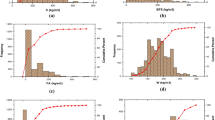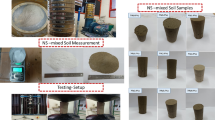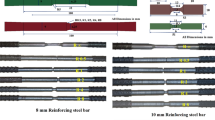Abstract
This manuscript employs a highly efficient artificial intelligence (AI) technique for machine learning (ML) through artificial neural networks (ANNs) and introduces a novel numerical predictive model capable of accurately forecasting the shear capacity of concrete-encased steel (CES) beams. The research begins by conducting shear tests on nine CES beams with high-strength steel, which addresses a significant gap in the shear performance of high-strength steel in CES beams. Subsequently, a comprehensive database of CES beam shear tests is established to train and validate the ANN model. The database consists of 242 sets of test data, compiled from published literature, encompassing a wide range of geometrical and material properties. A sensitivity analysis of the proposed model is then performed using a Pearson chi-square test to determine the relative importance of each input parameter on shear strength. Furthermore, a thorough examination is conducted to assess the impact of each parameter. Finally, the proposed predictive model is compared against current design codes, including ANSI/AISC 360–16 (USA, North America), BS EN 1994-1-1:2004 (Europe), and JGJ 138–2016 (China, Asia). The comparison reveals that ML technology exhibits higher accuracy and robustness in predicting shear bearing capacity.










Similar content being viewed by others
References
Zhou J, Chen Z, Xu W, Liao H, Wang N (2022) Seismic behavior of 3-D beam to L-shaped concrete encased steel composite column joint: an experimental study. J Build Eng. https://doi.org/10.1016/j.jobe.2022.104437
Hassan WM, Reyes JC, González C, Pallarés FJ, Spinel JS (2021) Seismic vulnerability and resilience of steel-reinforced concrete (SRC) composite column buildings with non-seismic details. Eng Struct. https://doi.org/10.1016/j.engstruct.2021.112810
Tao Z, Yu Q (2012) Residual bond strength in steel reinforced concrete columns after fire exposure. Fire Saf J 53:19–27. https://doi.org/10.1016/j.firesaf.2012.06.010
Wang J, Duan Y, Wang Y, Wang X, Liu Q (2021) Analysis and modification of methods for calculating axial load capacity of high-strength steel-reinforced concrete composite columns. Materials (Basel). https://doi.org/10.3390/ma14226860
Wang J, Wang X, Duan Y, Su Y, Yi X (2022) The investigation on mechanical performances of high-strength steel reinforced concrete composite short columns under axial load. Materials (Basel). https://doi.org/10.3390/ma15010329
Zhao X, Wen F, Chan T, Cao S (2019) Theoretical stress-strain model for concrete in steel-reinforced concrete columns. J Struct Eng. https://doi.org/10.1061/(asce)st.1943-541x.0002289
Yang Y, Chen Y, Feng S (2019) Study on behavior of partially prefabricated steel reinforced concrete stub columns under axial compression. Eng Struct. https://doi.org/10.1016/j.engstruct.2019.109630
Chen C, Lin N (2006) Analytical model for predicting axial capacity and behavior of concrete encased steel composite stub columns. J Constr Steel Res 62:424–433. https://doi.org/10.1016/j.jcsr.2005.04.021
Zhang S, Li X, Chen X, Chen J (2022) Behavior of circular-steel-tube-confined square CFST short columns under axial compression. J Build Eng. https://doi.org/10.1016/j.jobe.2022.104372
Zhang L, Zhang J, Tong J, Tong G, Li X, Xu Y (2021) Axial resistant behavior of bolt-connected CFST columns: experimental and numerical studies. Eng Struct. https://doi.org/10.1016/j.engstruct.2021.112918
Wang W, Li W, Song Q, Dong Y, Ding Q (2022) Performance of steel-reinforced square CFST stub columns loaded in axial compression: experiments. J Construc Steel Res. https://doi.org/10.1016/j.jcsr.2022.107197
Deyu Hao, Lewei Tong, Bo Liu, Gong H (2014) Review of research status on steel reinforced concrete beams. The 2nd International Conference on Large-Scale Structural Steel and Composite Structures. https://d.wanfangdata.com.cn/conference/8342184.
ANSI/AISC 360–16. Specification for Structural Steel Buildings. American institute of steel construction, Chicago. 2016; https://refhub.elsevier.com/S2352-7102(21)01484-4/sref15.
BS EN 1994–1–1. Eurocode 4: Design of Composite Steel and Concrete Structures-Part 1–1: General Rules and Rules for Buildings. European Committee for Standardization, Brussels. 2004; http://refhub.elsevier.com/S2352-7102(21)01484-4/sref16.
JGJ 138–2016. Code for design of composite structures. China Architecture & Building Press, Beijing. 2016; https://www.nssi.org.cn/nssi/front/106275786.html.
Bakas NP, Langousis A, Nicolaou MA, Chatzichristofis A (2023) Gradient free stochastic training of ANNs, with local approximation in partitions. Stochastic Environ Res Risk Assess 37:2603–17. https://doi.org/10.1007/s00477-023-02407-2
Markou G, Bakas N (2021) Prediction of the shear capacity of reinforced concrete slender beams without stirrups by applying A.I. algorithms. Comput Concrete 28:533–47. https://doi.org/10.12989/cac.2021.28.6.533
AlHamaydeh M, Markou G, Bakas N, Papadrakakis M (2022) AI-based shear capacity of FRP-reinforced concrete deep beams without stirrups. Eng Struct 264:114441. https://doi.org/10.1016/j.engstruct.2022.114441
Gravett DZ, Mourlas C, Taljaard V-L, Bakas N, Markou G, Papadrakakis M (2021) New fundamental period formulae for soil-reinforced concrete structures interaction using machine learning algorithms and ANNs. Soil Dynam Earthquake Eng 144:106656. https://doi.org/10.1016/j.soildyn.2021.106656
Chen C-C, Lin K-T, Chen Y-J (2018) Behavior and shear strength of steel shape reinforced concrete deep beams. Eng Struct 175:425–435. https://doi.org/10.1016/j.engstruct.2018.08.045
Jia J, Liu M, Yao D, Cai J (2013) Experimental investigation on shear bearing capacity of prestressed steel reinforced ultra-high-strength concrete beams. Buil Struct 43:23–6. https://doi.org/10.19701/j.jzjg.2013.21.005
Jia J, Yao D, Yu F (2014) Experimental study on shear capacity of prestressed I-steel ultrahigh reinforced concrete beams. Eng Mech 31:126–133. https://doi.org/10.6052/j.issn.1000-4750.2013.03.0155
Liu C, Zeng L, Liu Y (2020) The study of shear capacity of steel reinforced concrete deep beams based on modified softened strut-and-tie model. China Civil Eng J 53:47–52. https://doi.org/10.15951/j.tmgcxb.2020.s2.008
Xue J, Wang X, Ma H, Lin J, Chen Z (2013) Experimental study on shear performance of steel reinforced recycle aggregate concrete beams. Build Struct 43:69–72. https://doi.org/10.19701/j.jzjg.2013.07.015
Deng M, Ma F, Li B, Liang X (2017) Analysis on shear capacity of src deep beams based on modified strut-and-tie model. Eng Mech 34:95–103. https://doi.org/10.6052/j.issn.1000-4750.2016.08.0593
Wang Z (2006) Study on cracks and deflections of steel reinforced concrete beams. Xi’an: Xi’an University of Architecture and Technology. https://doi.org/10.7666/d.y970711
Bu L, Yang S (2021) Research on shear behavior of steel reinforced reactive powder concrete beams. J Shenyang Jianzhu University ( Natural Science). 37:787–95. https://doi.org/10.11717/j.issn
Wang B, Zhang W (2010) Analysis of shear behavior of steel reinforced high-strength and high-performance concrete beams. J Xi’an Technol Univ 30:354–9. https://doi.org/10.16185/j.jxatu.edu.cn.2010.06.008
Liu F, Weng X, Shao Y, Zhao H, Xi M (2009) Experiment and calculation of shear capacity of steel reinforced lightweight aggregate concrete beams. Build Struct 39:19–21. https://doi.org/10.19701/j.jzjg.2009.06.005
Yang Z (2015) Experimental study on shear behavior of steel ductile fibler reinforced concrete short beams and onlinear finite element. Xi’an: Xi’an University of Architecture and Technology. 2015, .https://xueshu.baidu.com/usercenter/paper/show?paperid=106t0tq0jj1r0ps0gr0b0gw01n641976&site=xueshu_se.
Deng M, Lu H, Yang K, Liang X (2015) Experimental study on shear behavior of steel reinforced high ductile concrete short beams. J Build Struct 36:73–80. https://doi.org/10.14006/j.jzjgxb.2015.10.009
Yang Y, Xue Y, Yu Y (2019) Research on the shear strength of precast steel reinforced concrete beams. Eng Mech 36:92–100. https://doi.org/10.6052/j.issn.1000-4750.2018.04.0217
Che S (2008) Research on basic behaviors and design theory of steel reinforced high strength and high performance concrete beams. Xi’an Xi’an Univ Architecture and Technol. https://doi.org/10.7666/d.d196375
China Academy of Building Research. Research report in reinforced concrete structure. Beijing: China Architecture & Building Press. 1994. https://books.google.co.jp/books?id=j4dEAAAACAAJ&newbks=1&newbks_redir=0&hl=zh-CN&redir_esc=y.
Deng M, Ma F, Wang X, Lü H (2020) Investigation on the shear behavior of steel reinforced NC/HDC continuous deep beam. Structures 23:20–25. https://doi.org/10.1016/j.istruc.2019.10.002
Tianshi Z (2010) Experimental research on oblique section shear capacity of prestressed composite concrete beam withencased H-steel. Ha’erbin: Northeast Forestry University. http://cdmd.cnki.com.cn/article/cdmd-10225-2010242748.htm.
Lu W (2006) Shear strength prediction for steel reinforced concrete deep beams. J Constr Steel Res 62:933–942. https://doi.org/10.1016/j.jcsr.2006.02.007
Yao D (2014) Experimental study on shear performance of prestressed steel ultrahigh reinforced beams. Dalian: Dalian University of Technology. 2014. https://d.wanfangdata.com.cn/thesis/Y2591843.
Cha Z (2021) Test and analysis of shear behavior of shaped steel reactive powder concrete beams. Yangzhou: Yangzhou University. https://doi.org/10.27441/d.cnki.gyzdu.2021.001587
Yang C (2017) Experimental study on shear behavior of steel reinforced recycled coarse aggregate concrete short beams. Guangxi: Guangxi University. https://doi.org/10.27034/d.cnki.ggxiu.2017.000018
Guo Y (2017) Experimental study on shear performance of steel reinforced concrete shallow beam in slim floors. Xi’an: Xi’an University of Architecture and Technology. https://doi.org/10.7666/d.D01302360
Cai J (2012) Study on shear behavior of prestressed steel reinforced ultra-high-strength concrete beams. Dalian: Dalian University of Technology. http://cdmd.cnki.com.cn/Article/CDMD-10141-1012394308.htm.
Zhang J (2001) Experimental study on shear bearing capacity of steel reinforced lightweight concrete beam. Liaoning: Liaoning Technical University. http://cdmd.cnki.com.cn/Article/CDMD-10147-2001000042.htm.
Lai B-L, Yang L, Xiong M-X (2021) Numerical simulation and data-driven analysis on the flexural performance of steel reinforced concrete composite members. Eng Struct. https://doi.org/10.1016/j.engstruct.2021.113200
Hasanzade-Inallu A, Zarfam P, Nikoo M (2020) Modified imperialist competitive algorithm-based neural network to determine shear strength of concrete beams reinforced with FRP. J Central South Univ 26:3156–3174. https://doi.org/10.1007/s11771-019-4243-z
Lee S, Lee C (2014) Prediction of shear strength of FRP-reinforced concrete flexural members without stirrups using artificial neural networks. Eng Struct 61:99–112. https://doi.org/10.1016/j.engstruct.2014.01.001
Hagan MT, Demuth HB, Beale M. Neural network design: PWS Publishing Co.; 1997. https://dl.acm.org/doi/abs/https://doi.org/10.5555/249049.
Qian C, Tan RK, Ye W (2022) An adaptive artificial neural network-based generative design method for layout designs. Int J Heat and Mass Transf. https://doi.org/10.1016/j.ijheatmasstransfer.2021.122313
Mohammadreza Z, Huu-Tai T (2022) Prediction of the load-shortening curve of CFST columns using ANN-based models. J Build Eng. https://doi.org/10.1016/j.jobe.2022.104279
Zarringol M, Thai HT, Thai S, Patel V (2020) Application of ANN to the design of CFST columns. Structures 28:2203–2220. https://doi.org/10.1016/j.istruc.2020.10.048
Li S, Zheng W, Xu T, Wang Y (2022) Artificial neural network model for predicting the local compression capacity of stirrups-confined concrete. Structures 41:943–956. https://doi.org/10.1016/j.istruc.2022.05.055
Rayner J, Thas O, Best DJ (2015) Statistical Distribution Models: Goodness of Fit Tests. Int Encyclopedia of the Soc Behav Sci. https://doi.org/10.1016/B978-0-08-097086-8.42047-7
Author information
Authors and Affiliations
Contributions
WJ: Resources, Supervision, Project administration, Funding acquisition, Writing—Review & Editing, Visualization, Supervision. CM: Term, Conceptualization, Methodology, Software, Validation, Formal analysis, Investigation, Data Curation, Writing—Original Draft, Writing—Review & Editing, Visualization, Supervision.
Corresponding author
Ethics declarations
Conflict of interest
We affirm that the work presented in this manuscript has not been published in any language and is not currently under consideration in any other journal. Furthermore, there are no conflicts of interest to declare. All authors have contributed to, reviewed, and approved this submitted manuscript in its current form.
Additional information
Publisher's Note
Springer Nature remains neutral with regard to jurisdictional claims in published maps and institutional affiliations.
Appendices
Appendix A
Tables
6 and
7.
Appendix B: The weight and bias for the ANN model
Rights and permissions
Springer Nature or its licensor (e.g. a society or other partner) holds exclusive rights to this article under a publishing agreement with the author(s) or other rightsholder(s); author self-archiving of the accepted manuscript version of this article is solely governed by the terms of such publishing agreement and applicable law.
About this article
Cite this article
Wang, J., Cui, M. Experimental investigation and predictive modeling of shear performance for concrete-encased steel beams using artificial neural networks. Mater Struct 56, 141 (2023). https://doi.org/10.1617/s11527-023-02226-5
Received:
Accepted:
Published:
DOI: https://doi.org/10.1617/s11527-023-02226-5




